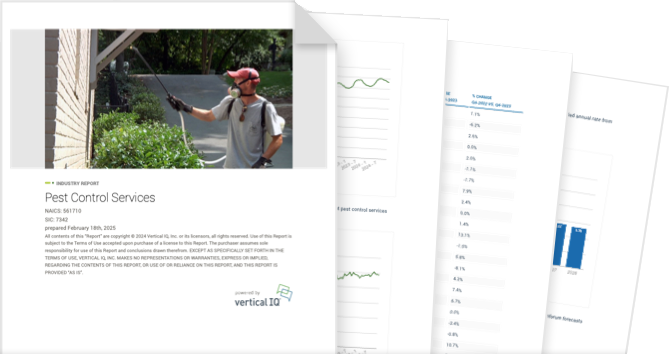US Agriculture, Forestry and Fishing Sector NAICS 11

Unlock access to the full platform with more than 900 industry reports and local economic insights.
Get access to this Industry Profile including 18+ chapters and more than 50 pages of industry research.
Industry Summary
The 1.9 million farms and establishments involved in agricultural support, forestry, fishing, and hunting make up the sector. Establishments in this sector are focused on propagating and harvesting plants and animals for food, materials, and sport. While the vast majority of operations are small or family-owned businesses, corporate enterprises are entering the sector at a growing rate.
Food Safety and Traceability
Intentional and unintentional contamination of the US food supply is a growing concern.
Reliance on Government Support
The agricultural and fishing subsectors benefit from government subsidies that increase income and reduce risk and costs.
Recent Developments
Dec 16, 2025 - $12 Billion in Aid to Farmers
- Long-awaited assistance for America’s struggling farmers, delayed by the government shutdown, arrived in December, The New York Times reports. At a White House event with farmers, President Trump unveiled a $12 billion rescue package with most of the relief funds coming from the USDA’s Farmer Bridge Assistance program. According to the Agriculture Department, the money will go to producers of corn, cotton, sorghum, soybeans, rice, wheat, and other row crops, with payments to farmers to be made by the end of February. The Trump administration will initially distribute $11 billion and is reserving another $1 billion to support growers of fruits and vegetables as needed, according to NYT. Still, the total payout to farmers could be far less than their recent losses caused by Trump’s tariffs and trade war with China, which caused China to retaliate by boycotting US farm products, most notably soybeans.
- US production of red meat fell again in 2025, according to the December Livestock Slaughter Report from the USDA’s National Agriculture Statistics Service (NASS). Year-to-date through the end of October, cattle slaughter declined 6.7% to 24.9 million head, marking the third consecutive year of decline, with the reduction in head slaughtered more than twice the magnitude of last year’s decrease. Volume losses in 2025 have been led by steers and heifers, down 4.7% and 7%, respectively. Declines in beef cow and bull slaughter have also been significant, with beef cow slaughter down 18.2% year over year to just below 2 million head, while bulls are down 10%. Record low cattle herd inventories and declining slaughter rates are driving up the price of beef, which is nearly 33% higher than in 2020, according to the Labor Department’s Consumer Price Index.
- Bipartisan legislation that aims to reduce the risk of wildfires on US forest lands passed a Senate committee in October, the Washington State Standard reports. The Fix Our Forests Act, introduced in the Senate in April and passed by the House, would promote prescribed burns, expand the state-federal Good Neighbor Authority program, increase collaboration among fire agencies, and improve reforestation efforts after fires. It also makes some rule changes that could impact how areas designated as high fire danger are managed and how projects in those areas proceed. The bill is backed by the timber industry and some environmental organizations, including the Nature Conservancy and National Audubon Society. Forest Service data shows that hazardous fuels reduction work across its lands was down 38% this year compared with the same period during the previous four calendar years. Federal cuts and a firefighter shortage are delaying mitigation efforts.
- According to a new report from NOAA Fisheries, there were 95 large whale entanglement cases documented in 2024, an increase from 2023 and higher than the historical average. 2024’s entanglement count is above the average annual number of confirmed entanglements over the previous 17 years, which was 71.4. The National Report on Large Whale Entanglements Confirmed in the United States in 2024, released in September, finds that entanglements in fishing gear or marine debris represent an ongoing threat to the welfare and recovery of many whale species, including species that are endangered and approaching extinction (e.g., North Atlantic right whales). Entanglements involving threatened or endangered species can have significant negative impacts on the population as a whole. NOAA's Atlantic Large Whale Take Reduction Plan has required some fishermen to use gear, like weaker ropes, that lower the risk of entanglement.
Industry Revenue
US Agriculture, Forestry and Fishing Sector

Industry Structure
Industry size & Structure
The agriculture, forestry, fishing, and hunting sector comprises 23,300 establishments and 1.9 million farms that together employ over 1 million workers and generate about $616.8 billion in annual revenue.
- The sector represents 1% of the nation's Gross Domestic Product (GDP) and employs 0.8% of the country's workers.
- The sector is highly fragmented, dominated by independent farms and owner-operated businesses.
- In addition to employer establishments, the agriculture, forestry, fishing, and hunting sector (aside from farms) has 255,956 owner-operated establishments with no employees. Subsectors with the highest numbers of nonemployer establishments are crop support services (26%); fishing (24%); and animal support services (23%). The owners of nonemployer firms typically perform the work and may outsource support functions like marketing and accounting.
- Overall employment in farming, fishing, and forestry occupations is projected to decline over the next decade. From 2022 to 2032, the agricultural workforce is expected to shed 16,000 jobs, with little or no change for fishing and hunting workers, according to the Bureau of Labor Statistics. Logging is projected to shed 2,400 jobs and forestry and conservation to decline by 1,000 positions.
Industry Forecast
Industry Forecast
US Agriculture, Forestry and Fishing Sector Industry Growth

Vertical IQ Industry Report
For anyone actively digging deeper into a specific industry.
50+ pages of timely industry insights
18+ chapters
PDF delivered to your inbox
